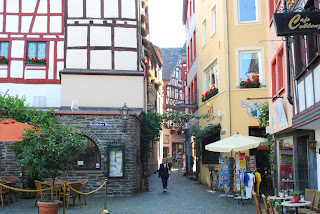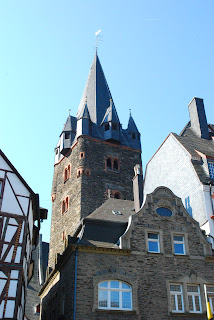Rothenburg was founded in 970 by a East Franconian Earl Reinger. It was not a town or city. It was a parish. He built the comburg castle with promontory above the river Tauber; thus the "ob der Tauber". Then for a 138 years his family lived, ran the place till the last of his heirs died off leaving the castle, lands and all to the monastery. Ha... Emperor Heinrich V wasn't having that took it all and gave it to his nephew Duke of Konrad who later becomes King of Germany. When he dies he has a 8 year old son Friedrich left behind. The Germans, I guess, didn't like the idea of being run by a kid put his cousin Friedrich Barbarossa in as King. Unlike a movie plot where he whacks the boy thinking he will supplant him someday his really good to the kid, Knights him at the age of 13 and lets him marry the daughter of King Richard the Lionhearted.
I wasn't aware that in Europe overall the Catholics had worn out their welcome and got stomped right and left. Their big cathedrals confiscated by protestants are run out or killed. Rothenburg was no exception with the main religion becoming protestant in1554. The King Friedrich Barbarossa decided the Pope Alexander III had to go and took the new young knighted boy with him. They traveled to Italy, kicked out the Pope and then was stricken by a plaque and the kid now about 15 years old dies. I suppose one could say, it isn't nice to fool with the Pope.
All in all, the town was ravaged over and over and then 40% of it bombed on 31st of March 1945. Already in the early 20th century they had caught on to the tourism thing with their medieval setting and rebuilt to that 16th century theme. So on to some pictures.
Okay... can't help it. We didn't go by bus. Although the USO does bus tours here. As I said, we went on our own.
Beauty in Rothenburg.
 The street is almost completely devoid of people. We got there real early, this picture was taken about 8 AM. Later, you'll see that after the buses came the place really started hopping.
The street is almost completely devoid of people. We got there real early, this picture was taken about 8 AM. Later, you'll see that after the buses came the place really started hopping.That's me.
That's her.
Covered walkway to keep the sentries dry during their watch.
The way into one of the corner towers. Then up to the top of the tower wall or down to carriage access to the inside storage areas and canon.
Sometime after the town became a Free Imperial City a general of the Emperor of Germany dropped by with his troops and ask to winter there. The towns folks said no. Big mistake; it hurt the generals feelings somewhat and after a bit of a battle the town caved in because their armory blew up and they had no more powder to fight with. 300 of the generals men were killed and 2 of the Rothenburg folks. Nevertheless, Rothenburg then had to pay war reparations to the general to the tune of 80,000 guildings. A literal fortune for the time and he got to winter there anyway. I can't imagine what got the backs up on the towns folks to refuse him in the first place. Perhaps it was the way he asked, no matter had they considered the commerance side of it they could have gotten guildings for goods and services instead of the other way around. I'll bet you a dollar for a donut the general and his men didn't pay for anything after that.
Now for a short visit to the path around the outside of the Rothenburg city wall.
Exiting the tower in to what was the moat area.
NO, No don't jump. It'll get better...
Then with one mighty leap I land on top of the city wall.
Ah, the famous scene. You can get this picture on places, place mats, fridge magnets, T-shirts and about anything else you can put a picture on only without the car and people.
This is the town square. Big building is the town government. Under the square is three dungeon cells that they use to throw people in to extract confessions or just torcher and just die. Rothenburg prospered under a mayor Toppler several centuries back. Toppler had at one time been a Special Forces type of guy for the Emperor before becoming mayor. He liked King Konrad later ousted by some other guy. Toppler had the bad taste to throw his support to the old king and wrote a letter or two suggesting his reinstatement. The new king got it and tossed Toppler, his son and nephew in the dungeon. Three months later Toppler croaked. Few weeks after that the son and nephew were let go and they had to sell all they had pay a huge fine and leave the city forever. Bummer...
Cool tree in the Christmas museum.
The landscape outside the city wall drops off rapidly as does the inside of the wall gradually climbs so by the time we get to the other end of town you get this kind of view from the wall.
There is a four story museum dedicated to criminal justice.
Disgraced women were put in this thing in the square. What constituted disgrace I can only imagine. Over the centuries this thing made its way around Europe. Somewhere along the way it ended up in France. Someone had drilled a bunch of holes in it a installed spikes. As far as anyone knows it was never intended to be an instrument of capital punishment and was never deployed as such. When the Germans got it back they took the spikes out.
Ah, the dunking cage. Got a beef and prove it in they go in the cage and then they get dunked "almost" to death in the river. For instance, if a baker produces a loaf to light in the cage he goes.
That's it for Rothenburg. It was a particularly nice place to visit.








































































